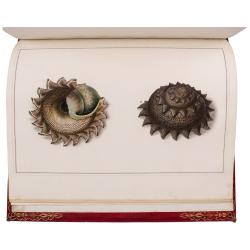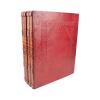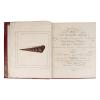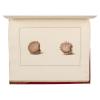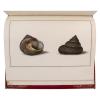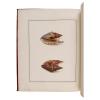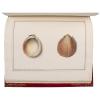Figures of non-descript Shells collected in the different Voyages to the South Seas since the year 1764 ... [Vols. I and II:] The Universal Conchologist, exhibiting the Figure of every known Shell, accurately drawn and painted after Nature: with a new systematic arrangement by the Author... [Vols. III and IV:].
Eur 88,000 / USD 96,800
The price shown on each item does not include V.A.T (Value Added Tax). As a result of the recent EU legislation we are required to charge our EU customers the percentage of V.A.T. charged by the customer’s country of residence, unless they possess a V.A.T. registration number. Postage Additional.
London, sold at his house no. 16 Great Marlborough Street, [1784-] 1789 [-1812]. 4 volumes. 4to (335 x 273mm), vol. I with engraved frontispiece of a shell, engraved title, engraved dedication to the King, two engraved plates of medals, pp. 27 [1, blank] letterpress text in English and French, engraved 'Explanatory Table', listing the shells and their sources, the three further volumes with engraved title and 'Explanatory Table' for each volume, with a total of 160 hand-coloured aquatint and watercolour plates (not counting the frontispiece) containing 355 figures, mostly depicting two views of a shell within a quadruple-ruled border; a few faint marginal waterstains on a few leaves, some very occasional marginal spotting, generally a very fresh, attractive copy, bound in contemporary full red straight-grained morocco, panelled in blind with interlocking panels on sides, spines tooled in blind, gilt ornaments on the turn-ins, gilt edges, with the bookbinder Welcher's label on free front endleaves.
A fine copy of one of the most attractive shell books ever produced
A rare complete set of 'The Universal Conchologist', in the large-format 'deluxe' issue (see below). A fine copy of one of the most attractive shell books ever produced. The first two volumes, devoted to shells of the South Seas, were originally published as a separate work in 1784. Martyn then extended the work to four volumes with an additional 80 plates. 'From the introduction to 'The universal conchologist' we learn that it was "to commence with the figures of shells (most of them rare and nondescript) which have been collected by several officers of the ships under the command of Captain Byron, Wallis, Cook, and others made to the South Sea" ... When the 'Resolution and the Discovery' returned from the third and last voyage in 1780 [the dealer] Humphrey purchased some more shells, but the bulk of the conchological spoils went this time to Thomas Martyn, a knowledgeable dealer, versatile writer and gifted artist ... Unlike Humphrey and other dealers who snapped up the Cook shells Thomas Martyn had more than a pecuniary interest in his purchases. Martyn's reason for wanting to corner the market in South Seas shells was entirely praiseworthy; although he sold many of the shells he had bought, he illustrated the finest in 'The Universal Conchologist', his magnum opus [and] a work which, for beauty, has seldom been surpassed in the history of conchological iconography' (Dance, A history of shell collecting).
Martyn purchased shells brought back from Cook's third voyage, although, as he wrote to Henry Seymer on 9 December 1780, 'I have purchased, amounting to 400 gns, more than 2 thirds of the whole brought home, Nevertheless I do not abound either in the variety of the new or many duplicates of the known ones that are valuable'. As a result, he modified his project and instead of presenting two shells on each plate, presented only one but depicted in two different views. Besides the specimens deriving from Cook's voyages, Martyn included specimens from the collections of the Duchess of Portland, the Countess of Bute, John Hunter, the Forsters, and others.
The fine plates were drawn by Martyn and engraved and coloured by his 'Academy' of young men whom he had trained as natural history artists. The plates, each showing a single species in two positions, were engraved in soft aquatint and printed lightly inked, so that when hand-coloured they would resemble watercolours.
Thomas Martyn (ca 1760-1816) was a native of Coventry, who lived in London at various addresses, 'most notably 10, Great Marlborough Street, Westminster, where he established his academy for the painting of Natural History. Besides the present work, his 'chef d'oeuvre', he published works on a dirigible balloon he designed, and various works of entomology, and colour theory.
The complete four-volume work is complicated by various issue points and varieties of format, dating, etc. There are variants amongst some of the plates, some being intended for the standard quarto issue, and others being adapted for the 'select' issue, which is often mounted on large sheets of blank blue-grey mounts. Unusually, the present copy contains the 'select' issue plates, but unmounted.
The single shell that serves as a frontispiece usually bears the caption 'Aphrodite' in Greek, and is framed by a gilt Greek key design; here it is uncaptioned and unframed. Several of the plates are also unframed. Otherwise the present copy conforms to the issue points of the 'select', folio issue, with the plates within larger frames. The following differences were first noticed by Dall: Plate 43 has two views of shell. There is only one view in the quarto. Plate 57 and 59; same remark. Plates 61 and 63, the figures are side by side. In the quarto (owing to the smaller page?) they are placed diagonally' (Dall, 'Supplementary notes' p. 186). I have also noticed that the following plates also differ, with the ones in the present copy being placed side-by-side within larger frames: 2, 30, and 35.
The plates are on heavy woven paper, some of it with an undated Whatman watermark. The format of the plates is altered from portrait to landscape, in rectangular rather than mostly square-ruled frames, and with the rules quadruple rather than double. As a result, here they are bound in sideways, with the plate numbers in the upper inner corner.
Nine plates in the present copy (see below) are signed by one of the artists trained by Martin, John Harris, who was an accomplished illustrator of numerous natural history works of the late eighteenth, early nineteenth century.
John Harris '(1767-1832), watercolour painter and illustrator, was born in London on 5 June 1767, the second son of Moses Harris (1730-c. 1788), the artist and entomologist. He was brought up at Deptford, which gave him a taste for marine subjects. He was articled c. 1780 to the entomologist Thomas Martyn, whose Academy for Illustrating and Painting Natural History was in Great Marlborough Street. Until about 1789 he also worked for James Edwards, the bookseller in Pall Mall, colouring prints and books. He exhibited landscapes and topographical subjects in watercolour at the Royal Academy from 1797, when he was living at Amelia Street, Walworth, to 1815, by which time he had moved to 27 Mansion House Row, Kennington.
'... According to a memoir by the son, which is tipped in a Bible now at the Houghton Library, Harvard, "as an Artist in the painting of Subjects of natural History Viz Insects, Shells &c &c He was I Believe, without a rival" (Weimerskirch, 249)' (Huon Mallalieu in ODNB; see P. J. Weimerskirch, 'John Harris, sr., 1767-1832: a memoir by his son', Book Collector, 42 (1993), pp 245-52).
Eight of the plates in vols III and IV are signed in ink 'J.H. pinx[i]t' and one, plate 144, is inscribed 'Paintd by J Harris Mansion House Street Kennington 1812' (plates 86, 87, 94, 119 in vol III and 138, 144 [signed], 150, 151, and 159 in vol IV). This date accords with other evidence that the last volume was not completed until early in the nineteenth century. It also tallies with the watermark date 1811 on the free endleaf of the final volume, indicating that the volumes were bound about that time.
The binder, Samuel Welcher, was partner with the other binder of 'select' copies, L. Staggemeier, at nos 11 and 12 Villiers Street in the Strand. Both were German émigrées and were in partnership as Staggemeier and Welcher from 1799 to 1809, after which Welcher remained at 12 Villiers Street.
The 'select' issue also differs in the letterpress setting and text in volume one, having the half-title 'The Universal Conchologist' on page 1, and 27 pages of text; the ordinary issue has 39 pages, divided into 'Introduction' and 'Preface'.
The engraved plate of medals honours noble patrons of the work (the Emperor of Germany, the King of Naples, the Pope). The first is dated 1788. and the second 1792.
See William Healey Dall, 'Thomas Martyn and the Universal Conchologist', Proceedings of the United States National Museum, vol XXIX, pp 415-432 (Washington 1905), and 'Supplementary Notes ...', idem, vol XXXIII, pp 185-192 (Washington 1907)
cf Ferguson I 4,40; Forbes I 79, 80, 175, 176; Nissen ZBI, 2728.

